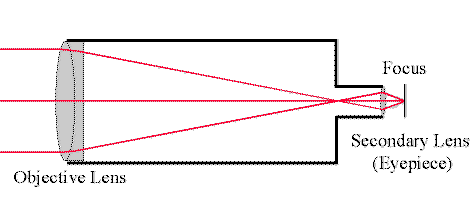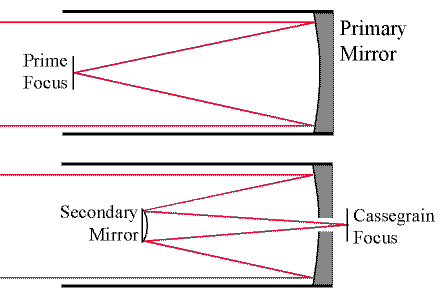

|
Astronomy 161:
An Introduction to Solar System Astronomy
Prof. Richard Pogge, MTWThF 9:30
|
Lecture 26: Telescopes
Key Ideas:
Types of Telescopes:
- Refracting (lenses)
- Reflecting (mirrors)
Observatory Sites
Special Telescopes:
- Radio Telescopes
- Space Telescopes
Extending Human Vision
The basic function of a telescope is:
- to gather light from a distant object, and
- concentrate (focus) the light into an image
The simplest telescope is the human eye:
- Lens focuses the light from an object into an image on
the retina at the back of the eye.
- Has a small collecting area (<1 cm2 for a
fully dilated pupil)
Light Gathering Power
The standard measure of a telescope is its
Light Gathering Power:
- Expressed as the total collecting area of the telescope.
- The greater the area, the more light collected.
We usually express the size of a telescope in terms
of the diameter of its primary collecting optic:
- Light Gathering Power increases as the square of
the diameter of the primary collecting optic.
Refracting Telescopes
Refracting Telescopes use lenses to gather and focus light.
- Original form of the telescope (Lipperhey's spy
glass & Galileo's telescopes)
- Large Objective Lens to gather and focus light.
- The objective lens is usually a compound lens to help correct
color distortions.
- Uses a series of smaller secondary lenses to form images for an
eye, camera, or spectrometer.
Refracting Telescopes were the most common type of telescope in use
before the early 1900s, and are still common for small personal
telescopes (binoculars are pairs of matched refracting telescopes).

(Click on the image to view at full scale [Size: 6Kb])
The size of a refracting telescope, and hence its light gathering
power, is limited by the size of the largest lens that you can make:
- Larger lenses are heavier, and tend to sag under their
own weight, ruining the image quality as the lenses distort.
- The long mounting tubes are hard to make mechanically stiff, and so
they tend to flex under the weight of the lens, making it hard to
keep the optics in alignment.
Largest Refractor: 40-inch Yerkes Telescope
- Located in Williams Bay, Wisconsin (run by University of Chicago)
- 40-inch diameter lens is mounted in a 69-foot steel tube, and housed
in a 75-foot diameter steel dome.
Visit the Yerkes
Observatory webpage for more info and pictures.
Reflecting Telescopes
The Reflecting Telescopes uses curved mirrors. It was invented by James
Gregory & Isaac Newton.
- Primary Mirror gathers and focuses light
- Use secondary mirrors to direct the light to cameras and
spectrometers.
All modern large telescopes are reflecting telescopes.

(Click on the image to view at full scale [Size: 9Kb])
Advantages of Reflecting Telescopes:
- Mirrors can be supported from behind, and thus can be
made very large.
- The largest single mirrors ever built are 8.4-meters (27.6 ft) in diameter
for the Large Binocular Telescope.
Currently, the largest reflecting telescopes in operating are the two
Keck 10-meter telescopes on Mauna Kea in Hawaii:
- Use 36 smaller hexagonal segments to build up the
collecting area, all working together under computer
control.
Plans are afoot to build a new generation of 20- and 30-meter telescopes
in the next 10-15 years. In principle, there is no limit to the size of
a reflecting telescope except the money to build and operate it.
Mountain-Top Observatories
Telescopes need to be located at special remote sites. The
requirements of these sites are:
- Dark Skies, far from large cities
- Clear, Dry Weather
- Good "seeing" (steady atmosphere to reduce
twinkling & smearing of images)
The best observatory sites are high, dry mountain peaks. Examples
of prime observatory sites are:
- The Chilean Andes near the Atacama Desert
- The summit of Mauna Kea on Hawaii
- Mountains in Arizona (Kitt Peak, Mt. Hopkins, Mt. Graham)
To see what the Earth looks like at night from composite satellite
imagery (the source of the image of the US at night I showed in
lecture), visit the Images page of the
International Dark-Sky
Association.
The Largest Telescopes
The last few years has seen the construction of very large (8-10 meter)
telescopes. This sudden burst of activity has been initiated by
technological breakthroughs in large mirror design. The links below lead
to the webpages for these projects.
10-meter Keck I
and II:
- Two independent telescopes with segmented 10-meter mirrors
- Run by Caltech, University of California and NASA
- Currently in operation on Mauna Kea
8.2-meter Subaru:
- Single 8.2-meter meniscus, a thin sheet of glass held in
the correct shape by an active mechanical superstructure.
- The flagship telescope of the National Astronomical Observatory
of Japan
- Currently in operation on Mauna Kea
8.1-meter GEMINI Telescopes:
- Single 8.1-meter meniscus design, like Subaru.
- Run by a consortium of the US, UK, Canada, Chile, Brazil,
Argentina, & Australia.
- Gemini North is located on Mauna Kea, Gemini South is
located on Cerro Pachon in Chile. Both are now in full operation.
8-meter Very Large
Telescopes (VLT):
- Four 8-meter meniscus design telescope, each works independently.
- Located on Cerro Paranal in the Atacama desert of Chile.
- Run by the European Southern Observatory (consortium of
EU nations)
- All 4 telescpes are in operation.
2x8.4-meter Large Binocular Telescope:
- Two 8.4-meter honeycomb mirrors on a common mount
(binocular), gives an equivalent collecting area of a
single 11.3-meter mirror.
- Run by a consortium of Arizona, Italy, Germany, Ohio
State, Research Corporation, Notre Dame, and Minnesota.
- Under construction on Mt. Graham in Arizona, first light
for Mirror 1 was October 2005.
- Should begin full 2-mirror operations in late 2008.
Radio Telescopes
Use antennas to detect cosmic radio waves:
- Radio-wavelength lines of Hydrogen and Molecules (CO)
from cold interstellar gas
- Radio emitted by hot electrons, or electrons accelerated
by strong magnetic fields.
Interferometry:
- Trick of ganging together many smaller telescopes to
achieve the higher resolution of a large single dish
(aperture synthesis).
Space Telescopes
Only radio waves, visible light, and some infrared light
penetrate the atmosphere.
Need to go into space to observe all others:
- Infrared Telescopes
- Ultraviolet Telescopes
- X-Ray and Gamma-Ray Telescopes
They are very expensive ($Billions) to build and operate, and only
a few are in operation at any given time.
Examples of recent space observatories (not a complete list):
- Hubble Space Telescope:
- UV, Visible, & near-IR imaging & spectroscopy telescope
- Run by NASA and ESA (European Space Agency)
- Spitzer Space Infrared
Telescope:
- Thermal infrared imaging & spectroscopy telescope
- Run by NASA (IPAC at Caltech)
- Chandra X-Ray Observatory:
- X-ray imaging and spectroscopy.
- Run by NASA (Chandra Science Center at Harvard)
- XMM-Newton X-Ray Observatory:
- X-ray imaging and spectroscopy.
- Run by ESA
- Far Ultraviolet Spectroscopic
Explorer (FUSE):
- Far-Ultraviolet spectroscopy
- Run by NASA (FUSE Science Center at Johns Hopkins)
Return to [
Unit 4 Index
|
Astronomy 161 Main Page
]
Updated: 2006 October 27
Copyright © Richard W. Pogge,
All Rights Reserved.

